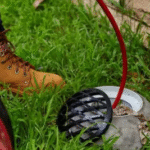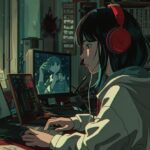What is your research process like?
I just go to the library and get lost. I walk almost unconsciously through the isles, stop when my spirit tells me, and grab the book that I’m “looking” for. After gathering about 10 books or so, I have everything to help me come to a conclusion on what I want to say in my work. After the books, I speak with “random” people in my community to get their opinions and ideas about the whatever the topic is. Funny enough, this usually confirms my thoughts. After that, I watch documentaries and news stories to inform myself visually and to stay up to date.
In what ways have you found that we glorify war?
Glorification of wars and war heroes are all around. I see it in movies like Troy and 300. Kids are getting rewarded for kill streaks online everyday. I saw many Republicans during the campaign bringing veterans on stage to talk about our nation’s good vs the evil brown people of the Orient. Our president, Trump, is trying to fight a war of attrition against ISIS, another good v. evil case. ISIS glorifies its martyrs and soldiers in this so called “holy Caliphate v evil Crusaders” war.
Tell me about the significance of the materials you use for Glory, and how you apply them onto canvas. (I imagine that this process is a performance piece in itself!)
It was a performance! I laid the work out on the floor, spilled paint on it to stain the canvas, and used a broom to paint the rest in. After, I spit on it and slopped mud everywhere. Then I finished it off with glitter. I actually got fired from my job while working on that piece because of the mess I made. My boss was pissed.
Haha, anyways, I used mud, blood red paint, and spit in the areas that represent the battlefield. The blue areas are filled with glitter and the figures are almost like constellations in the night sky. To me it’s a timeless heaven and earth view of the Battle of Gaugamela plains, Iraq and the current battles going on in the same area of Mosul, in our times.
The figures in the work are holding the traditional weaponry of Persian and Macedonian warriors. In many areas you can see the Macedonian battle technique of the phalanx being used by the figures. There are other symbols in the work, and they refer back to Picasso’s Guernica; the fallen horse, the slain warrior with the broken blade, the flowers and the black bird in the top right.
You’ve scattered silhouettes throughout this body of work, as if they’re peering into our world. Tell me a bit about mixing the abstract with the figurative.
Haha! They’re there to watch the viewers. I only include them when the time is right though. Like when a brush stroke does not carry the emotional weight of seeing a human locked in combat.
Thank you, Nazish! Soooo many all-nighters in the studio. A lot of “Watch the throne.” And a ton of frustrating moments. It was fucking amazing! I like having a fire under my ass when I work.
Thanks for taking a look at everything, Nazish! This is going to sound boring, but agriculture, hunting, and food is my dream subject! I want to cover it so badly. If you control food, you control the world. I believe that crops and livestock are the only thing on this planet with intrinsic value. One ear of corn can produce fifty more. I’d probably talk about farming throughout history, slaves from around the world, what people grow all across the planet, hunting, gathering, and how it’s shaped their food, culture, and modern society. It’d be a lifetime’s journey around our planet.









